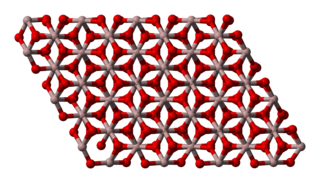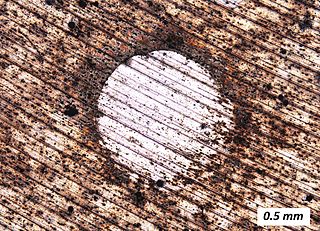Related Research Articles

Beryllium is a chemical element with the symbol Be and atomic number 4. It is a relatively rare element in the universe, usually occurring as a product of the spallation of larger atomic nuclei that have collided with cosmic rays. Within the cores of stars, beryllium is depleted as it is fused into heavier elements. It is a divalent element which occurs naturally only in combination with other elements in minerals. Notable gemstones which contain beryllium include beryl and chrysoberyl. As a free element it is a steel-gray, strong, lightweight and brittle alkaline earth metal.

Aluminium oxide is a chemical compound of aluminium and oxygen with the chemical formula Al2O3. It is the most commonly occurring of several aluminium oxides, and specifically identified as aluminium(III) oxide. It is commonly called alumina and may also be called aloxide, aloxite, or alundum depending on particular forms or applications. It occurs naturally in its crystalline polymorphic phase α-Al2O3 as the mineral corundum, varieties of which form the precious gemstones ruby and sapphire. Al2O3 is significant in its use to produce aluminium metal, as an abrasive owing to its hardness, and as a refractory material owing to its high melting point.
Beryllium copper (BeCu), also known as copper beryllium (CuBe), beryllium bronze and spring copper, is a copper alloy with 0.5–3% beryllium and sometimes other elements. Beryllium copper combines high strength with non-magnetic and non-sparking qualities. It has excellent metalworking, forming and machining properties. It has many specialized applications in tools for hazardous environments, musical instruments, precision measurement devices, bullets, and aerospace. Beryllium alloys present a toxic inhalation hazard during manufacture.

Duralumin is a trade name for one of the earliest types of age-hardenable aluminium alloys. Its use as a trade name is obsolete, and today the term mainly refers to aluminium–copper alloys, designated as the 2000 series by the International Alloy Designation System (IADS), as with 2014 and 2024 alloys used in airframe fabrication.

The mechanical structure of an aircraft is known as the airframe. This structure is typically considered to include the fuselage, undercarriage, empennage and wings, and exclude the propulsion system.

Alnico is a family of iron alloys which in addition to iron are composed primarily of aluminium (Al), nickel (Ni) and cobalt (Co), hence acronym al-ni-co. They also include copper, and sometimes titanium. Alnico alloys are ferromagnetic, and are used to make permanent magnets. Before the development of rare-earth magnets in the 1970s, they were the strongest type of permanent magnet. Other trade names for alloys in this family are: Alni, Alcomax, Hycomax, Columax, and Ticonal.

Glass laminate aluminum reinforced epoxy (GLARE) is a fiber metal laminate (FML) composed of several very thin layers of metal interspersed with layers of S-2 glass-fiber pre-preg, bonded together with a matrix such as epoxy. The uni-directional pre-preg layers may be aligned in different directions to suit predicted stress conditions.
Aluminium–lithium alloys are a set of alloys of aluminium and lithium, often also including copper and zirconium. Since lithium is the least dense elemental metal, these alloys are significantly less dense than aluminium. Commercial Al–Li alloys contain up to 2.45% by mass of lithium.
7075 aluminium alloy (AA7075) is an aluminium alloy, with zinc as the primary alloying element. It has excellent mechanical properties, and exhibits good ductility, high strength, toughness and good resistance to fatigue. It is more susceptible to embrittlement than many other aluminium alloys because of microsegregation, but has significantly better corrosion resistance than the 2000 alloys. It is one of the most commonly used aluminium alloy for highly stressed structural applications, and has been extensively utilized in aircraft structural parts.
Materion Corp. is a multinational company specializing in high-performance engineered materials. Among their products are precious and non-precious metals, inorganic chemicals, specialty coatings, beryllium, specialty engineered beryllium, beryllium copper alloys, ceramics, and engineered clad and plated metal systems.

Alclad is a corrosion-resistant aluminium sheet formed from high-purity aluminium surface layers metallurgically bonded to high-strength aluminium alloy core material. It has a melting point of about 500 degrees celsius, or 932 degrees Fahrenheit. Alclad is a trademark of Alcoa but the term is also used generically.
Semi-solid metal casting (SSM) is a near net shape variant of die casting. The process is used today with non-ferrous metals, such as aluminium, copper, and magnesium, but also can work with higher temperature alloys for which no currently suitable die materials are available. The process combines the advantages of casting and forging. The process is named after the fluid property thixotropy, which is the phenomenon that allows this process to work. Simply, thixotropic fluids flow when sheared, but thicken when standing. The potential for this type of process was first recognized in the early 1970s. There are three different processes: thixocasting, rheocasting, thixomolding. SIMA refers to a specialized process to prepare aluminum alloys for thixocasting using hot and cold working.
Glidcop is a family of copper-based metal matrix composite (MMC) alloys mixed primarily with small amounts of aluminum oxide ceramic particles. It is a trademark of North American Höganäs. The name is sometimes written GlidCop or GLIDCOP.
AlBeMet is the trade name for a beryllium and aluminium metal matrix composite material derived by a powder metallurgy process. AlBeMet AM162 is manufactured by Materion Corporation Brush Beryllium and Composites.
2219 aluminium alloy is an alloy in the wrought aluminium-copper family. It can be heat-treated to produce tempers with higher strength but lower ductility. The aluminium-copper alloys have high strength, but are generally less corrosion resistant and harder to weld than other types of aluminium alloys. To compensate for the lower corrosion resistance, 2219 aluminium can be clad in a commercially pure alloy such as 1050 or painted. This alloy is commonly formed by both extrusion and forging, but is not used in casting.
5456 aluminium alloy is an alloy in the wrought aluminium-magnesium family. While it is closely related to 5356 aluminium alloy, it is used in structural applications, like most other aluminium-magnesium alloys, and not as filler for welding. As a wrought alloy, it can be formed by rolling, extrusion, and forging, but not casting. It can be cold worked to produce tempers with a higher strength but a lower ductility. It is susceptible to exfoliation corrosion when held at temperatures above 65 °C (150 °F) for extended periods of time.
6005 aluminium alloy is an alloy in the wrought aluminium-magnesium-silicon family. It is closely related, but not identical, to 6005A aluminium alloy. The main difference between the two alloys is that 6005 has a higher minimum composition percentage of aluminium than 6005A. The most common forming method is extrusion. It can also be forged or rolled, but as a wrought alloy it is not used in casting. It cannot be work hardened, but is commonly heat treated to produce tempers with a higher strength at the expense of ductility.
6005A aluminium alloy is an alloy in the wrought aluminium-magnesium-silicon family. It is closely related, but not identical, to 6005 aluminium alloy. Between those two alloys, 6005A is more heavily alloyed, but the difference does not make a marked impact on material properties. It can be formed by extrusion, forging or rolling, but as a wrought alloy it is not used in casting. It cannot be work hardened, but is commonly heat treated to produce tempers with a higher strength at the expense of ductility.
6262 aluminium alloy is an alloy in the wrought aluminium-magnesium-silicon family. It is related to 6162 aluminium alloy, but sees much more widespread use. It is notably distinct from 6162, and most other aluminium alloys, in that it contains lead in its alloy composition. It is typically formed by extrusion, forging, or rolling, but as a wrought alloy it is not used in casting. It can also be clad, but that is not common practice with this alloy. It cannot be work hardened, but is commonly heat treated to produce tempers with a higher strength but lower ductility.
The 6463 aluminium alloy is an aluminum alloy in the wrought aluminium-magnesium-silicon family. It is related to 6063 aluminium alloy, but unlike 6063 it is generally not formed using any processes other than extrusion. It cannot be work hardened, but is commonly heat treated to produce tempers with a higher strength but lower ductility. Like 6063, it is often used in architectural applications.
References
- ↑ McGraw-Hill Dictionary of Scientific & Technical Terms, 6E, Copyright © 2003 by The McGraw-Hill Companies, Inc.
- 1 2 3 Parsonage, Tom. "Development of Aluminum Beryllium for Structural Applications" (PDF). Materion. Retrieved May 9, 2018.
- ↑ Cameron, Kevin (August 5, 2015). "ESSAY: When is the Future Coming?". Cycle World. Retrieved May 9, 2018.
- ↑ DTIC ADA041284: Lockalloy Be-38Al Material Characterization, 1976 Year-End Report, by Defense Technical Information Center
- ↑ Hausner, Henry Herman (1965). Beryllium its Metallurgy and Properties. University of California Press. p. 189. ISBN 978-0520005419.